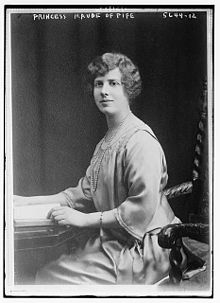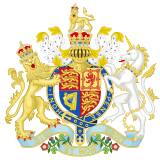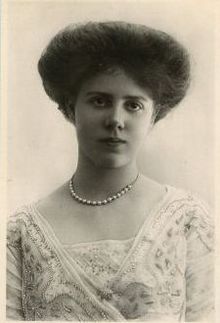- Princess Maud, Countess of Southesk
-
Princess Maud Countess of Southesk 
Spouse Charles Carnegie, 11th Earl of Southesk Issue James Carnegie, 3rd Duke of Fife Full name Maud Alexandra Victoria Georgina Bertha Carnegie Father Alexander Duff, 1st Duke of Fife Mother Louise, Princess Royal Born 3 April 1893
East Sheen Lodge, Richmond-upon-ThamesDied 14 December 1945 (aged 52)
LondonPrincess Maud, Countess of Southesk (Maud Alexandra Victoria Georgina Bertha Carnegie; née Duff; 3 April 1893 – 14 December 1945) was a member of the British Royal Family, a female line granddaughter of King Edward VII. Maud, and her elder sister, Alexandra, had the distinction of being of being two of only five female-line granddaughters of a British Sovereign to receive the style Highness. (Three of Queen Victoria’s female-line granddaughters had previously been styled as Highness, albeit holding the style from birth: Princess Helena Victoria of Schleswig-Holstein, Princess Marie Louise of Schleswig-Holstein and Princess Victoria Eugenie of Battenberg.) Maud and her sister also received the title of Princess but it was not specified if this conferred the title of Princess of Great Britain and Ireland.
Although Princess Maud did not normally carry out royal engagements, she served as a Counsellor of State between 1942 and 1945.
Contents
Early life
Maud was born at East Sheen Lodge, Richmond-upon-Thames, Surrey on 3 April 1893. Her father was the 1st Duke of Fife (1840–1912), the son of the 5th Earl Fife and his wife, the former Lady Agnes Hay. He was created Duke of Fife following marriage to Maud's mother, then Princess Louise of Wales, the eldest daughter of Albert Edward, Prince of Wales (later King Edward VII) and Alexandra of Denmark.
As a female line great-granddaughter of a British monarch (Queen Victoria), Maud was not entitled to the title of a Princess of Great Britain or the style Royal Highness. Instead she was styled Lady Maud Duff, as the daughter of a Duke. She was sixth in the line of succession at the time of her birth.
Maud and her sister were unique among British princesses in that they were descended from both William IV (through his mistress, Dorothy Jordan), and William IV's niece, Queen Victoria, who succeeded him because he had no legitimate issue.
Princess Maud
In 1900, Queen Victoria granted Maud's father a second Dukedom of Fife in the Peerage of the United Kingdom with a special remainder providing for the succession of the Duke's daughters and their male descendants to the title, in default of a male heir. Maud became second in line to the Dukedom after her sister, Lady Alexandra Duff.
On 5 November 1905, King Edward VII gave Maud's mother the title of Princess Royal. He further ordered Garter King of Arms to gazette Maud and her sister Alexandra with the style and attribute of Highness and precedence immediately after all members of the British Royal Family bearing the style of Royal Highness. From that point, Her Highness Princess Maud of Fife held her title and rank not from her father (a Duke), but rather from the will of the Sovereign (her grandfather).
British Royalty House of Saxe-Coburg and Gotha 
Edward VII Albert Victor, Duke of Clarence & Avondale George V Louise, Princess Royal Princess Victoria Maud, Queen of Norway Prince Alexander John Maternal grandchildren Alexandra, Duchess of Fife Maud of Fife On 13 November 1923, Maud married Lord Carnegie (23 September 1893 – 16 February 1992) at the Royal Military Chapel, Wellington Barracks, London. Lord Carnegie was the eldest son of the 10th Earl of Southesk and inherited the title of Earl of Southesk on his father's death on 10 November 1941.
Following her marriage, Maud ceased to use the title of Princess and the style Highness and was known as Lady Carnegie, and later The Countess of Southesk. Her uncle, King George V, disapproved of his father's elevation of the Duke of Fife's daughters to the rank of Princess. In accordance with his wishes, she simply stopped using her royal title, although no formal declaration, Letters Patent, or Royal Warrant to that effect appeared. However, she technically still held the title and style and remained a Princess and Highness to her death. In some official documents, she was still styled Princess Maud.
Maud and her husband operated a model farm at Elsick, in Kincardineshire, Scotland.
Maud and her husband had one child:
- James George Alexander Bannerman Carnegie, 3rd Duke of Fife, 12th Earl of Southesk (b. 23 September 1929).
Later life
Maud was considered a member of the British Royal Family, although she did not undertake official and public duties. She attended the coronations of her uncle, George V, in June 1911 and her first cousin, King George VI in May 1937. During George VI's absence in Africa in 1943, Maud served as a Counsellor of State. At the time of her death in 1945, she was thirteenth in line to the British throne and next in line to the dukedom of Fife, since her sister Alexandra's only son, Alastair Windsor, 2nd Duke of Connaught and Strathearn had died in 1943. Maud's only son, Lord Carnegie, succeeded his aunt as 3rd Duke of Fife in 1959. He succeeded to his father's titles in 1992.
Maud died in a London nursing home in December 1945 after a bout of acute bronchitis.
Titles, styles, honours and arms
Royal styles of
Princess Maud
Reference style Her Highness Spoken style Your Highness Alternative style Ma'am Titles and styles
- 3 April 1893 – 5 November 1905: The Lady Maud Duff
- 5 November 1905 – 12 November 1923: Her Highness Princess Maud of Fife
- 12 November 1923 – 10 November 1941: Lady Carnegie
- 10 November 1941 – 14 December 1945: The Rt Hon The Countess of Southesk
Legally, Maud remained a Princess of Great Britain and Ireland with the style of Highness until her death.
Ancestry
British princesses The generations indicate descent from George I, who formalised the use of the titles prince and princess for members of the British Royal Family. Where a princess may have been or is descended from George I more than once, her most senior descent, by which she bore or bears her title, is used.1st generation 2nd generation 3rd generation - Augusta, Duchess of Brunswick
- Princess Elizabeth
- Princess Louisa
- Caroline Matilda, Queen of Denmark and Norway
4th generation 5th generation 6th generation 7th generation - Louise, Princess Royal and Duchess of Fife
- Princess Victoria
- Maud, Queen of Norway
- Marie, Queen of Romania
- Victoria Melita, Grand Duchess of Hesse
- Alexandra, Princess of Hohenlohe-Langenburg
- Beatrice, Duchess of Galliera
- Margaret, Crown Princess of Sweden
- Patricia of Connaught
- Alice, Countess of Athlone
- Marie Louise, Princess Maximilian of Baden
- Alexandra, Grand Duchess of Mecklenburg-Schwerin
- Olga of Hanover
8th generation 9th generation - Queen Elizabeth II
- Margaret, Countess of Snowdon
- Alexandra, The Hon Lady Ogilvy
10th generation 11th generation Categories:- 1893 births
- 1945 deaths
- People from Richmond, London
- British princesses
- Women of the Victorian era
- People of the Edwardian era
- Deaths from bronchitis
Wikimedia Foundation. 2010.

